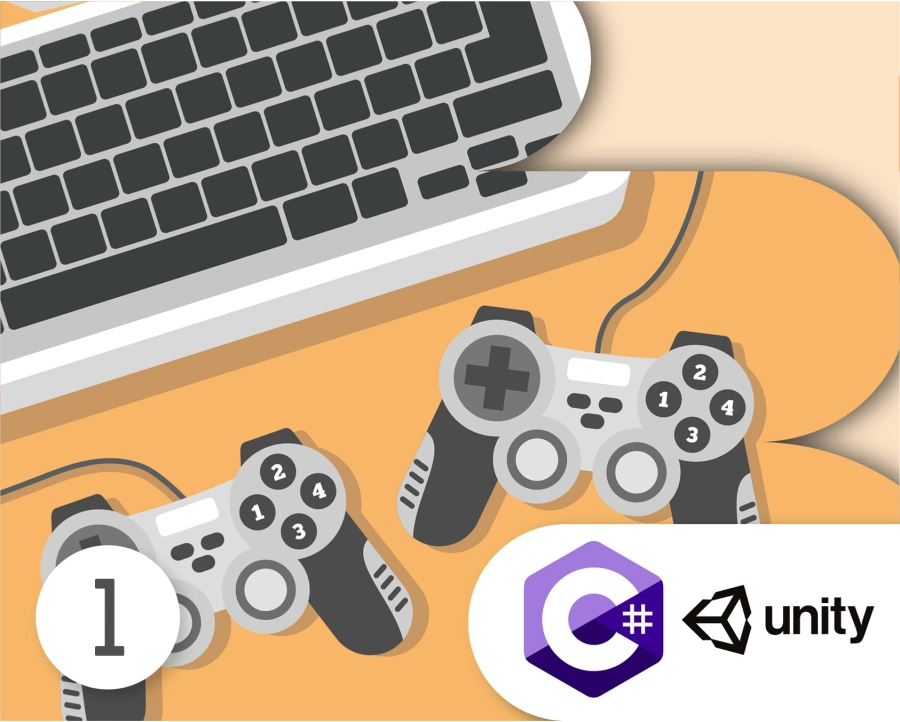European Union

Creating Computer Games in Unity Semester 1 Online COPY OF 250
Classes for students who have completed the Introduction to Coding in C#.
Developing games in Unity is learning about the principles of designing your own games using the C # language and the Unity engine. Thanks to this, we can create games based on similar mechanics as League of Legends, Cyberpunk, Counter Strike and many, many others.
Intro
The participants will learn the ways and methodology of creating computer games, both 2D and 3D. UNITY 3D is used as a game development engine. In the second semester part of the lesson will be devoted to modeling 3D elements in Blender. After this course students will be able to create an advanced computer game on their own.
Plan of the course
The first classes will be devoted to revision of the material. After a longer break, it is worth recalling the basics, which were reworked during the previous semesters.
During the second lesson the Unity 3D engine will be used. Students will get acquainted with the interface of the program, learn the basic elements of which the game consists. They will start a simple project of a UFO game where they will write a script, thanks to which they will move the spaceship around the board.
The third class will be a continuation of the previous ones. They will apply new elements related to 2D physics, so that the ship will not run away from the board but will also be able to earn points and display them.
Time for the project for the rest of the semester. This lesson will be devoted to Game Design Document to show how important it is to design games accurately at the very beginning.
During the next classes, time will be devoted to preparing a prototype of the game. Pupils will put their first materials on the game objects. They will also create a script that will allow the character to jump in the air and make the so-called double jump.
It's time to prepare the level for moving on or actually moving it. The script written during these classes will allow for a little cheating. It's the world that will move towards the player creating the illusion that it's him or her who is running on it. We will also start counting our points.
What is this game where you do nothing but run? We'll add obstacles that we'll have to avoid and the ability to control the difficulty level. The game can't be boring after all.
In the game, it happens that something goes wrong. That's why during these classes, students learn how to reload scenes to restart the level in case of a something goes wrong.
We give character to the project. These classes will be devoted to the appearance of levels, heroes or traps. Graphics and animations prepared beforehand will be added to implement them.
Money rules the world. So it will be added to the game to earn points and try to break your record with subsequent attempts. We will also add platforms so that the game does not work on just one level.
PowerUP... Today immortality will be programmed. At least temporary. We will prepare the collectibles, obtaining them during the game will have additional effects for our hero.
Let us finally build a decent world. Or at least let it build itself. With the help of a few prepared prefabs our charts will be generated randomly. Thanks to that each game will be unique.
We will be working on the interface and menus for the last time. Somehow the game has to start, from somewhere we need to know how many points we have. We will also add music that will accompany us in the game.
It's time for the final touches. Correction of bugs, defects and a cherry on the cake. Export to computer and Android. The most important issues will be discussed and finally we export to boast our game to others.
The first classes will be devoted to the game's operation. The differences between 2D and 3D games will be discussed. Game Design Doc will be prepared and students will learn what is project version control based on GitHub and Columbus is.
In these classes the students will prepare the player's controller using the internal Unity CharacterController component. In addition to moving the player, they will prepare a script for the camera, through which they will watch the game world.
Now the students will prepare some special mechanics. They will program a stopwatch that will measure how much time is left to find the finish line. They will also create a mechanism to pause the game and end it, i.e. win and lose.
Now the students will prepare some special mechanics. They will program a stopwatch that will measure how much time is left to find the finish line. They will also create a mechanism to pause the game and end it, i.e. win and lose.
We will start working on portals, thanks to which players will be able to move to another part of the maze. These activities will be devoted to building a portal object.
The next classes will be a continuation of the portals. We will create scripts that will allow a smooth transition between the portals, and we will also create several security features to make the portal work properly.
Time for 3D graphics. During these classes students will learn the basics of Blender 3D. They learn how to model and what are the components of the model. They will also prepare the first graphics for the game.
With the help of the teacher, students will create their own 3D graphics, which they will use in the created game. They will learn a few modelling tricks to make their projects more attractive.
After creating the models and polishing it is time to export to Unity. Students will add the models they have created to the project and then add scripts related to their mechanics.
If there are PickUps you can add animations. Students will set their models in motion. By the way, they will create a trap mechanism as well as a mechanism to open the door with a key.
It is time to finally prepare your labyrinth. During these classes, a script will be prepared that will allow students to generate labyrinths according to their ideas. They will prepare the finish of the game and add the sky to the project.
When we have a maze ready, it is worth to make it more attractive by adding traps, doors or pickups. Each student will create their own unique level of game.
The finished level can be made even more attractive. These classes will be devoted to materials to add color to the objects. Then, post-process will be discussed, thanks to which students will be able to completely change the so-called The flow of your game. Finally, music and sounds will be introduced.
The last classes will be devoted to the game interface. Two-dimensional graphics will be introduced to inform the player about the time remaining, whether he is under the influence of a pickup or whether he finally reached the finish line. A simple Main Menu will also be created. And finally, we export our game to show off to friends.
Satisfaction Guaranteed!
It is possible to cancel a purchase after the first class!
Let us know if you have more questions!


